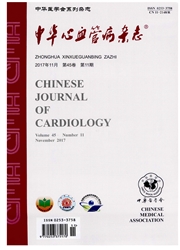

 中文摘要:
中文摘要:
目的探讨三维电解剖标测(CARTO)系统重建图像和预先取得的磁共振影像融合后指导心房颤动(房颤)导管消融的有效性。方法从2005年9月至2006年9月对连续100例药物治疗无效的房颤患者行导管消融治疗,基本策略均为在CARTO系统指导下进行环肺静脉线性消融并实现电学隔离。随机分为2组,每组50例。第1组为术前配准组,在消融开始前即进行影像配准并融合,并在此融合影像指导下进行导管消融,消融结束后进行再次融合;第2组为术后配准组,在单纯CARTO技术指导下消融,消融结束后才进行影像配准并融合。最后比较两组的消融结果并评估消融过程中的差异。结果环肺静脉消融结束后,第1组左心房三维磁共振表面重建影像至电解剖标测图像各点平均距离为(1.6±0.7)mm,消融线上平均标记位点(75±27)个,平均X线透视时间(31±21)min;第2组的上述指标分别为(2.1±1.3)mm、(98±38)个、(55±29)min。以上组间比较差异都有统计学意义。将实际消融线与预定消融线比较,第2组中有组间差异的偏差区域分别是左侧肺静脉前庭顶部(15例)、底部(11例)、前下缘(23例)、前上缘(24例)和右侧肺静脉前庭后上缘(12例)、底部(10例)、前下缘(15例)。结论影像融合技术指导导管消融可提高准确性,并可减少X线透视时间及消融点数。
 英文摘要:
英文摘要:
Objective To investigate the efficacy of integrated electroanatomic mapping with preacquired magnetic resonance (MR) images guided catheter atrial fibrillation ( AF ) ablation. Methods From September 2005 to September 2006, 100 consecutive drug-refractory AF patients underwent catheter ablation (circumferential pulmonary vein (PV) linear ablation and electrical isolation) guided by a three- dimensional (3D) electroanatomic mapping system. Patients were randomly divided into two groups (n = 50 each group). Registration before ablation group: integrated electroanatomic mapping with preacquired 3D MR images processed before ablation procedure; registration after ablation group: ablation procedures guided by CARTO system only. After ablation, image integration was processed in both groups. Results Sinus rhythms were maintained in 32/50 and 33/50 patients without antiarrythmics 3 months post ablation ( P 〉 0. 05 ). Upon completion of the circumferential lesions around the PVs, the distance between the surface of the registered 3D MR left atrium (LA) reconstruction and multiple electroanatomic map points was significantly shorter [ ( 1.6 ± 0. 7 ) mm vs. ( 2. 1 ± 1.3 ) mm], radiofrequency application location points were significantly less (75 ±27 vs. 98 ± 38 ) and the total fluoroscopy time were also significantly shorter [ (31 ± 21 ) min vs. (55 ± 29) min] in the registration before ablation group compared to registration after ablation group ( P all 〈 0. 05 ). Mismatch numbers between the practical ablation line and calculated ablation line were significantly higher in registration after ablation group compared to registration before ablation group (142/213 vs. 71/213, P 〈0. 05). Conclusion Integrated three-dimensional electroanatomic mapping with preacquired MR images technique could improve accuracy of catheter ablation, reduce fluoroscopy time and ablation location points for AF patients underwent ablation.
 同期刊论文项目
同期刊论文项目
 同项目期刊论文
同项目期刊论文
 Metabolic syndrome in patients with atrial fibrillation in the absence of structural heart disease f
Metabolic syndrome in patients with atrial fibrillation in the absence of structural heart disease f Comparison of contrast enhanced 64-slice computed tomography and transesophageal echocardiography in
Comparison of contrast enhanced 64-slice computed tomography and transesophageal echocardiography in Transesophageal high intensity focused ultrasound ablation of left atrium posterior wall: new method
Transesophageal high intensity focused ultrasound ablation of left atrium posterior wall: new method 期刊信息
期刊信息
